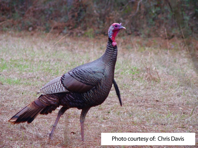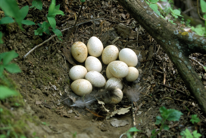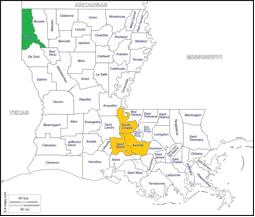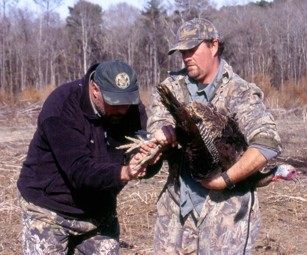Wild Turkey Restoration in Louisiana
An Interview with Jimmy Stafford
by Elizabeth Robinson
Department of Environmental Sciences
Louisiana State University, Baton Rouge, LA 70803
“I would consider a restoration a success when a population grew and became viable for hunting.” ~ Jimmy Stafford
Eastern wild turkeys (Meleagris gallapavo silvestris) are one of the largest native game birds in the US. Male gobblers and female hens express sexual dimorphism. An adult gobbler has black tipped breast feathers, a beard, a pair of spurs, and weigh between 17-25 lbs. (Figure 1). An adult hen is smaller, weighing between 8-11 lbs., has light brown tipped breast feathers, and does not have a pair of spurs or a beard (Figure 2). These birds typically mate between February and April and build nesting sites on the ground with surrounding vegetative cover (Figure 3). Hens typically lay clutches of 10 eggs and incubate for 26-28 days. The hatching success of eggs is dependent upon rain, temperature, drought, and predation. Hatching success and poult (juvenile, Figure 2) survival are essential in sustaining wild populations.
Figure 1: Male turkey.
www.wlf.Louisiana.gov/turkey
Figure 3: Turkey nest.
Photo Courtesy of: NWTF
Figure 2: Female turkey(right) with poult
(left).www.wlf.Louisiana.gov/turkey
HABITAT CONSERVATION: Louisiana had approximately 1,500 turkeys in 1946. The population today is estimated to be 60,000. Currently, the population appears to remain stable with no signs of increasing or decreasing. Conserving habitat is important to keep this populations stable. Turkeys require large tracks bottomland hardwood pine, and mixed pinehardwood forest to support their social structure, as well as dietary and roosting needs.
Although 50-75% of original hardwood forest has been gobbled up by farms, roads, and cities, approximately one million acres of land is actively managed to preserve hardwood habitat in the second or third generation of growth, thanks to the efforts of many state and federal agencies. Other tracks of hardwood land exist in private ownership.
These private and public acres often remain as fragments that are too small to maintain wild turkey populations. Mr. Jimmy Stafford, the Biologist Program Manager for LDWF and the Louisiana Chapter of the National Wildlife Turkey Federation (NWTF), says,
“You can’t just put them (turkeys) out on 500-1,000 acres of woods and expect them to make it long term… We finally had to draw a minimal acreage that was continuous … 4,000 acres. That’s probably a little low and should be higher than that.”
RESEARCH: There are two ongoing turkey research projects in Louisiana. The projects are managed, funded, and conducted by the Louisiana Wildlife and Fisheries, the National Wild Turkey Federation, the University of Georgia, and Louisiana State University.
Figure 4: The Louisiana parishes
where these two
Project One: Caddo Parish (Figure 4, green parish)
With support from a private land owner, research is being conducted looking at the survival and behavioral patterns of restocked turkeys.Turkeys are outfitted with GPS telemetry packs and identification tags and then released into an area (Figure 5). The turkeys’ location and reproductive success is monitored.One hundred turkeys have been stocked in this location since the 1990s. However, the populations of the birds has not increased. Research is directed at answering ‘why’ this is so.
Project Two: Point Coupee, Iberville, and Saint Martin Parishes (Figure 4, yellow parishes)
Figure 5: Attaching telemetry pack (Top Left); Measuring spur length(Top Right); Radio telemetry tracking of turkeys (Bottom Left);
Telemetry pack on a turkey (Bottom Right). All Photos Courtesy of Jimmy Stafford.
The Morganza Spillway was opened in 2011 to reduce the water level of the Mississippi River. Flooding of the hardwood habitat occurred overnight, stranding roosting turkeys in the trees. After three weeks, turkeys began to fall out of the trees due to the exhaustion of resources. The turkey population was reduced to about one-third of their original population size.
Research in this area is being conducted to see if the reproduction rate increases due to the
change in “social carrying capacity.” Turkeys do not seem to have a food carrying capacity. For years, it has been thought that their nesting habitat and brooding habitat was limiting the population size. But that does not appear to be the case here. Like the Caddo Parish project, turkeys are monitored with telemetry packs (Figure 5).
ADDITIONAL RESOURCES:
National Wild Turkey Federation, www.nwtf.org
Louisiana Wild Turkey Federation, www.lanwtf.org
Louisiana Department of Wildlife and Fisheries, www.wlf.louisiana.gov/turkey
Cornell Lab of Ornithology, http://www.allaboutbirds.org/guide/wild_turkey/lifehistory






